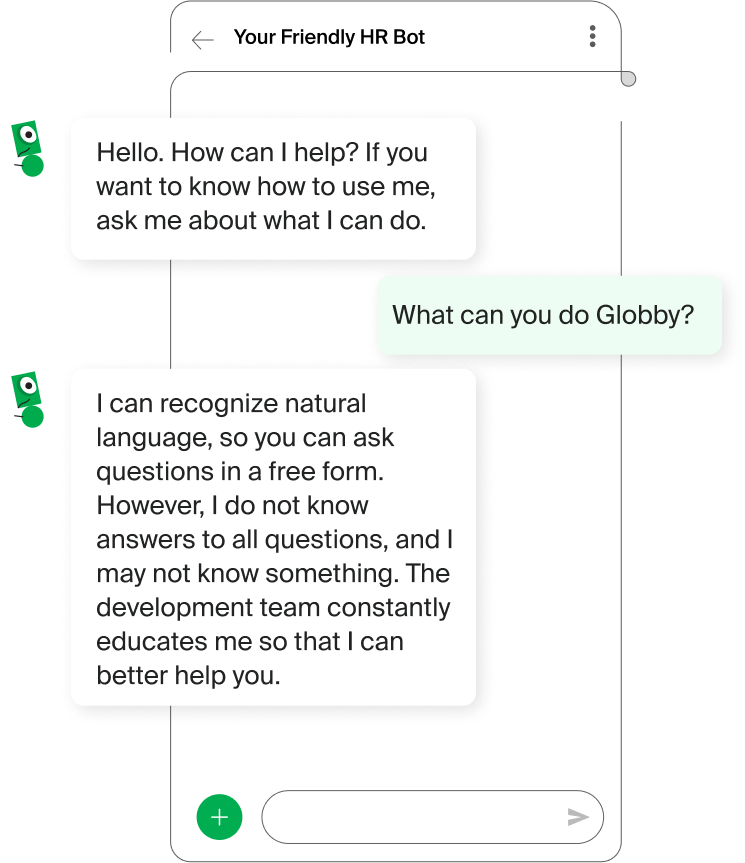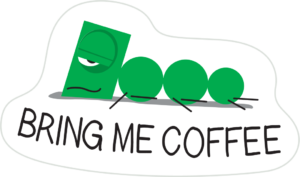When overloaded with administrative work, HR professionals can have a tough time focusing on person-to-person interactions and complex employee issues. That’s why many of them are turning to Artificial Intelligence (AI) to automate repetitive conversations and improve onboarding processes. Thanks to breakthrough developments in Natural Language Understanding (NLU) technologies, AI-powered chatbots can now handle complex queries and support a growing number of HR use cases.
Recent research suggests that 52% of HR employees already use this technology, while 41% plan to adopt it in near future. An important takeaway from the study is that 94% of those who already use AI chatbots rate them as good or excellent, showing an overwhelmingly positive attitude towards it.
At GMS, we’ve been using GMS AI chatbots for HR for months, and we love the results. In this article, we’ll discuss them with Elena Stupakova, Head of Learning and Development at GMS.

Q: Hello Elena! Thanks for joining us to share your department’s experience with GMS AI Chatbots. Can you tell us why you decided to implement this solution?
Elena: Employee engagement is a priority for GMS as we believe every individual needs to have a sense of dedication and accomplishment at work. Our HR department is focused on creating experiences for our team members to help them feel informed, empowered, and cared for. However, our day-to-day activities also involve different administrative tasks and procedures, which can take up too much of our time if not properly handled. That’s why we’re always looking for ways to improve our internal processes and free up more time for complex employee issues.
When GMS launched AI Chatbots, we were the first department to ask for access. We recognised the potential of this technology, and we were curious to try it ourselves. And after several months, I can confidently say it helped in the following aspects:
- Time savings as many repetitive queries are handled by the chatbot
- Productivity boost in HR as we have more time to dedicate to complex tasks
- Increased employee satisfaction as their queries get resolved in minimum time
- Onboarding efficiency with AI chatbot helping guide new hires
When we talk about some more specific outcomes, I’d say we’ve seen at least a 10%-15% increase in productivity since we started a few months ago. Now as more employees get used to leveraging it, we expect this percentage to increase significantly in future.

Q: Was it difficult to promote the HR chatbot when it first launched? How did employees react?
Elena: I admit it was a new solution for many of our employees. Most haven’t had a chance to use something like this in their previous organisations either, so it took some time for them to develop a habit of referring to it. We deployed our HR chatbot in Teams as this is the primary communication channel in our organisation. In several weeks, most employees discovered how easy it is to start a conversation with it and get answers to different questions.
Some of them admitted they like the anonymity of AI chatbots as they felt free to ask questions they thought would be a bit silly to ask managers or HR [LAUGHS].
As for the promotion part, that took some time initially, but I’d say it caught up fast after that. Once we had the chatbot installed, I sent a couple of email notifications through our HR system and through our internal social network to encourage the use. In these notifications, I gave some examples of the questions the chatbot can respond to, which I think helped build awareness.
Another important thing we did was share info about our chatbot in onboarding videos to encourage new hires to use it. As expected, being new to the company, they had many questions and sometimes they were too shy to ask. That’s why they found AI Chatbots helpful and were quite comfortable using it. Therefore, onboarding was another successful use case for this tool.

Q: Can you give us some examples of what sort of information employees are looking for?
Elena: There’s quite a lot and that’s good because it helps the chatbot self-learn. The more people use it in different ways, the better it gets at recognising their requests and providing adequate answers. That’s why we encourage employees to ask anything that comes to their mind at any time.
These are some of the most common inquiries:
- Organisational chart access link
- Onboarding videos access link
- Navigating SharePoint sites and files
- Understanding persons responsible for a particular area
- Understanding whom to ask for help with a particular problem
- Checking about benefits and work conditions per each office location
- Asking about payroll processes (as long as it’s not sensitive)
- Considering career development paths
- Managing time off and holidays
- Asking about GMS logo and brand book
- Asking about medical insurance
Q: How closely have you worked on its implementation?
Elena: The implementation wasn’t as complex as I would expect, I tell you that. Our team already had some pre-configured chatbots and pre-defined inputs, so it was easy for us to build upon that. We sat together to define intents, vocabularies, and suggest flows, which were added to our platform. And it was very exciting to see the chatbot in action when it went live!
To be honest, there were some challenges too. As we are a big company with offices on multiple locations in Europe and Asia, we needed to tailor some of the chatbot responses to a particular country. This is mostly related to legal and medical insurance information, as these differ from country to country. But we managed to solve that and now I think we’re even better equipped to serve the needs of our international employees.
Q: GMS’s chatbot also has a familiar personality. How did you decide on that?
Elena: That was the most exciting part! We’ve used our company Brand Hero as the chatbot persona. This made the most sense as our employees are already familiar with Globby, a communication caterpillar that we use in our promotional and brand messaging. We thought this was a great way to bring Globby to life and also make the new chatbot more approachable.
Globby is one of the first things new employees learn about when they join the company, as it’s featured on our branded materials they receive on their first day. Then they are introduced to the Globby chatbot as part of their onboarding process and this makes them quite comfortable using it. This proved to be a very successful strategy for us and is definitely something I’d recommend to other organisations. Make your AI Chatbot familiar, recognisable, and approachable to encourage more engagements.

Q: Thank you, Elena. Any last piece of advice for your colleagues?
Elena: As our chatbot Globby would say, always happy to help!
I am glad I had a chance to share our amazing results with our readers and I hope this will help my colleagues from other organisations embrace this useful tool. I understand that implementing new HR technologies tends to be a challenging and complex process that requires buy-in from multiple stakeholders, but there are so many positive examples of the use of HR chatbots already. I would recommend it to all teams focusing on employee engagements, as it can be a truly powerful way to keep your teams informed and engaged. AI chatbots have an impressive potential for our department, and I think it should be easy to build a case for them for your CxOs and IT teams.
For further details on HR Chatbots by GMS, we encourage you to reach out to sales@gms-worldwide.com. Our team would be happy to demo it for you or answer any questions.

